The short-eared owl is a beautiful bird species that goes by a number of other names including prairie owl, marsh owl, and grass owl. Their names are derived from the type of territory that these majestic creatures like to dwell in. They prefer open country, low scrublands, marshes, and grasslands.
The English have given them an entirely different nickname called Shorties. Birdwatchers can rejoice because the short-eared owl is in plentiful supply on five of the seven continents. They don’t have a presence in Australia or Antarctica, but they can be found everywhere else.
Right now, I’d like to tell you much more about the wonderful short-eared owl population in greater detail. I’m going to cover a number of important topics that include the following:
- How to quickly and easily identify short-eared owls
- Important and fun short-eared owl facts
- Short-eared owl differences between males and females
- Migratory habits, nesting behaviors, feeding habits, dietary preferences
- More important short-eared owl facts
To find out much more about these majestic nocturnal creatures, please keep reading below.
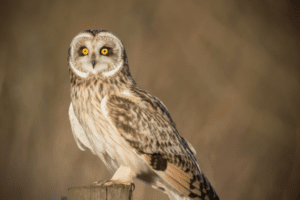
Short-Eared Owl Bird Facts
- Common Name: Short-eared owl
- Scientific Name: Asio flammeus
- Scientific Family: Strigidae
- Life Span: 4-12 years
- Size: 13.0 to 17.0 inches
- Wingspan: 33.0 to 43.0 inches
- Weight: 7.3 to 16.8 oz
- Conservation status: Least Concern
How To Identify A Short-Eared Owl
The short-eared owl has a medium build, white and buff on the upper parts of its body, and spotted Brown throughout the rest of its body. It has a pale face, and yellow eyes, and its eyes have black outlines going around them.
The breast of the short-eared owl is streaked with heavy streaks of brown. The belly and chest are buffy or pale.
Differences Between Male & Female
The major difference between female and male short-eared owls is that the males have power-looking colors. Otherwise, they look relatively the same and are nearly the same in size.
Differences In Summer Plumage vs Winter Plumage
Short-eared owls appear to maintain the same color plumage during Winter, Spring, Summer, and autumn.
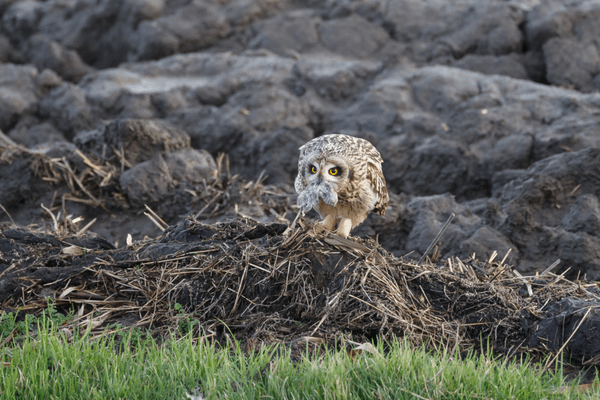
Where You’ll See Short-Eared Owls
For the most part, you’ll find an abundant concentration of short-eared owls when there is an abundant amount of available prey. For the most part, these beautiful owls are found regularly in tundras, dunes, marshes, and prairies. They can also be found in open countries, in particular in areas where there are lots of small rodents available as prey.
Most commonly, you’ll find Shorty or owls nesting in coastal prairies, inland prairies, farmland, marshes, and tundras. During the winter, these birds tend to stick to shrubby areas, coastal dunes, small Meadows, and stubble fields.
As mentioned earlier, short-eared owls live abundantly throughout the United States, Canada, and parts of Mexico. They maintain permanent residences in the northwestern states of the United States and parts of Canada. But they are available in plentiful supply as non-breeding residents throughout the rest of the United States.
Short-Eared Owl Migration Patterns
Unlike many other owls that remain sedentary in their favorite territory, certain short-eared owls living in colder climates are migratory birds. Although, they do not possess a regular migration pattern. These birds are nomadic and migrate irregularly based on the temperature and weather.
For the most part, the majority of short-eared owls in the western part of the Washington lands and valleys are just visiting for the winter. They move into areas that are warmer than other parts of Washington state.
Diet and Feeding Preferences
The short-eared owl diet mainly consists of eating rodents. Voles are usually the prey that’s most prevalent and easy enough to feed on. But they also eat other rodents including pocket mice, deer mice, and lemmings.
Besides rodents, they and other small mammals as well including muskrats, bats, gophers, rabbits, and shrews. And when they live in coastal regions, they will even eat other small birds.
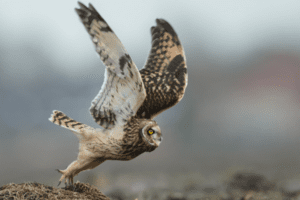
Short-Eared Owl Nesting Facts
- Clutch Size: 1-11 eggs
- # of Broods: 1-2 broods
- Incubation Period: 21-37 days
- Nestling period: 12-18 days
- Egg Description: Cream/white
The owl will keep its nest site on dry ground. You can find it on a raised ridge or hummock. This is especially true when they are living in marshes. They like to keep their nest safe and protected under a shrub or hidden within the tall grass. You’ll very rarely find a short-eared owl nest above ground.
The female Shorty owl builds their nest within the soil in a depression. She will line the nest with feathers and grass to make it cozy and comfy for her and her hatchlings.
Short-Eared Owl Behavior
- Active behavior of short-eared owls, unlike many other owls, are actually around and active during the daytime. This makes it a lot easier to spot short-eared owls when compared to other owl species.
- These owls are mainly active at dusk and dawn. So, if you want to get a glimpse of your favorite short-eared owl, you should look for it during these particular times of the day.
- During courtship, the male owl will perform courtship flights that are quite dramatic. These courtship flights contain wing clapping and vocalizing in a very loud and noticeable manner. These courtship flights happen during the breeding season.
- Short-eared owls like to live on open terrain. You’ll find them active during the daylight in marshes and prairies. The owl will fly low over a field while hunting, which is how you’ll know when it’s in the middle of catching its prey.
- The short-eared owl finds its prey in the daytime by sight and sound.
Tips for Birdwatchers On How To Attract Short-Eared Owls
As a property owner, one of the best ways to attract these owls to your backyard is to let them manage your pests.
What does that mean? It means that instead of using exterminators or rodenticides, just allow this creature to take care of your potential rodent problems. This will attract many more of these owls to your backyard because they will have a plentiful supply of rodents to capture along with other small mammals that they consume as food.
These owls nest on the ground, so it’s important to be very careful of potential nesting places for these beautiful raptors. When you’re cutting the lawn, make sure to steer clear of potential ground nests because this could damage the nest and potentially harm the owls and their young during nesting season.
There’s no need to hang a nesting box in your backyard to attract these owls. They build their nests on the ground, so a nesting box isn’t going to be very attractive to this particular owl species. It’s a good idea if you’re looking to attract other types of owls that are known to live in your vicinity, but it will not attract the short-eared owl whatsoever.
Leaving an available water source for short-eared owls is always a brilliant idea. They use this water to drink and bathe themselves and their young. It makes it easy for these incredible raptors to remain clean and hydrated with healthy freshwater.
Avoid mowing the lawn too often as well. Small rodents and other mammals like to hide in the long grass. This creates opportunities for short-eared owls to easily catch and consume small rodents, voles, mice, and other smaller creatures.
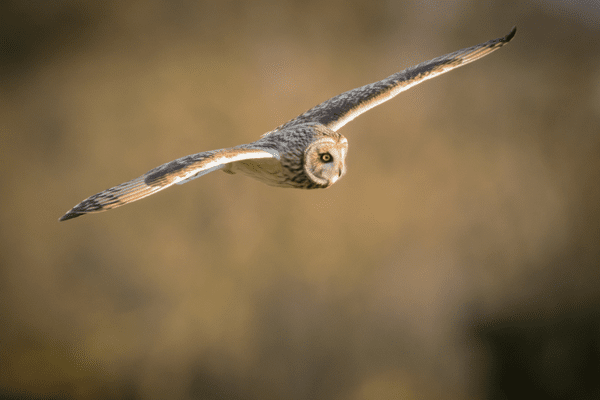
Conservation Status
The short-eared owl is considered to have the Least Concern conservation status in North America. In fact, this owl species is considered one of the most widely distributed throughout the entire world.
Nevertheless, since 1970 in North America, the species has in a regular presence throughout its typical range. Its population has also declined by 65%. The North American range of the short-eared owl covers the majority of Canada and large portions of the northern US.
Fun & Interesting Facts
- The short-eared owl lives on the Hawaiian Islands. This doesn’t seem like a major accomplishment at first, but it’s actually only one of two owl species that live in Hawaii. It arrived here naturally by traveling to the area from Alaska. The barn owl is the only other owl species living in Hawaii as well.
- Short-eared owls are known for traveling long distances. While migrating, it’s been documented that they can travel up to as much as 1200 miles. Many of the distances traveled are overwater, which is an amazing feat in itself. On occasion, breeding populations are discovered on remote oceanic islands.
- Short-eared owls are known for nesting on the ground. Many owls avoid this practice and prefer nesting in shrubs or trees. The female creates the nest via feathers, herb stocks and grass stems that are scraped together.
- The mail short-eared owl has an elaborate courtship ritual to attract females. The ritual is part of a particular flight that is quite beautiful in nature. The male will clap its wings quite audibly underneath its body. When it claps its wings, it sounds like it’s cracking a whip. These wing claps take place incredibly quickly in fast bursts of 10 claps per second.
- After being born, the short-eared owl would begin leaving the nest within 14-18 days old. Even though it cannot fly yet, it will spend its days walking or running around on the ground. More than likely, this young short-eared owl will remain close to the nest and continue to receive care and food from its parents.
Explore More Species in This Family
- Long-Eared Owl
- Burrowing Owl
- Barred Owl
- Great Grey Owl
- Boreal Owl
- Northern Saw-Whet Owl
- Eastern Screech-Owl
- Flammulated Owl
- Northern Hawk Owl
- Snowy Owl
- Northern Pygmy-Owl
- Elf Owl
- Spotted Owl
- Western Screech-Owl
from BirdInformer.com https://ift.tt/YPuUm3X

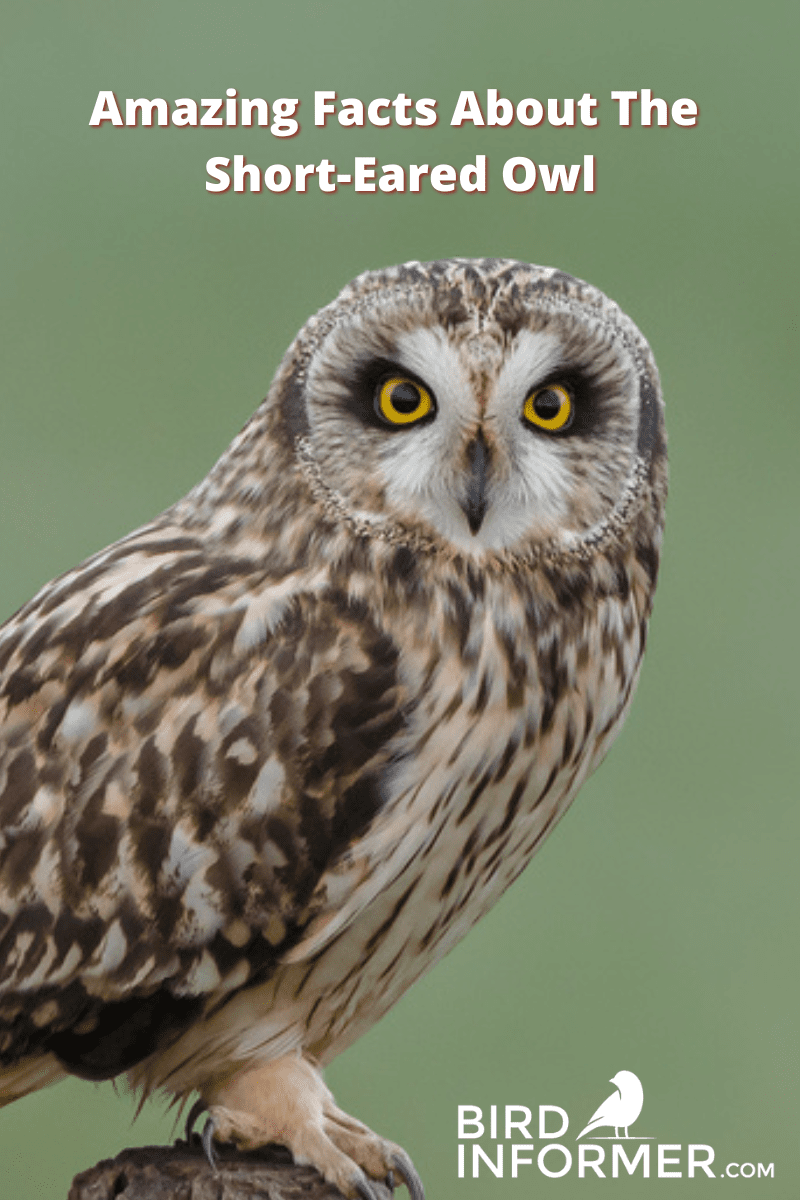
No comments:
Post a Comment